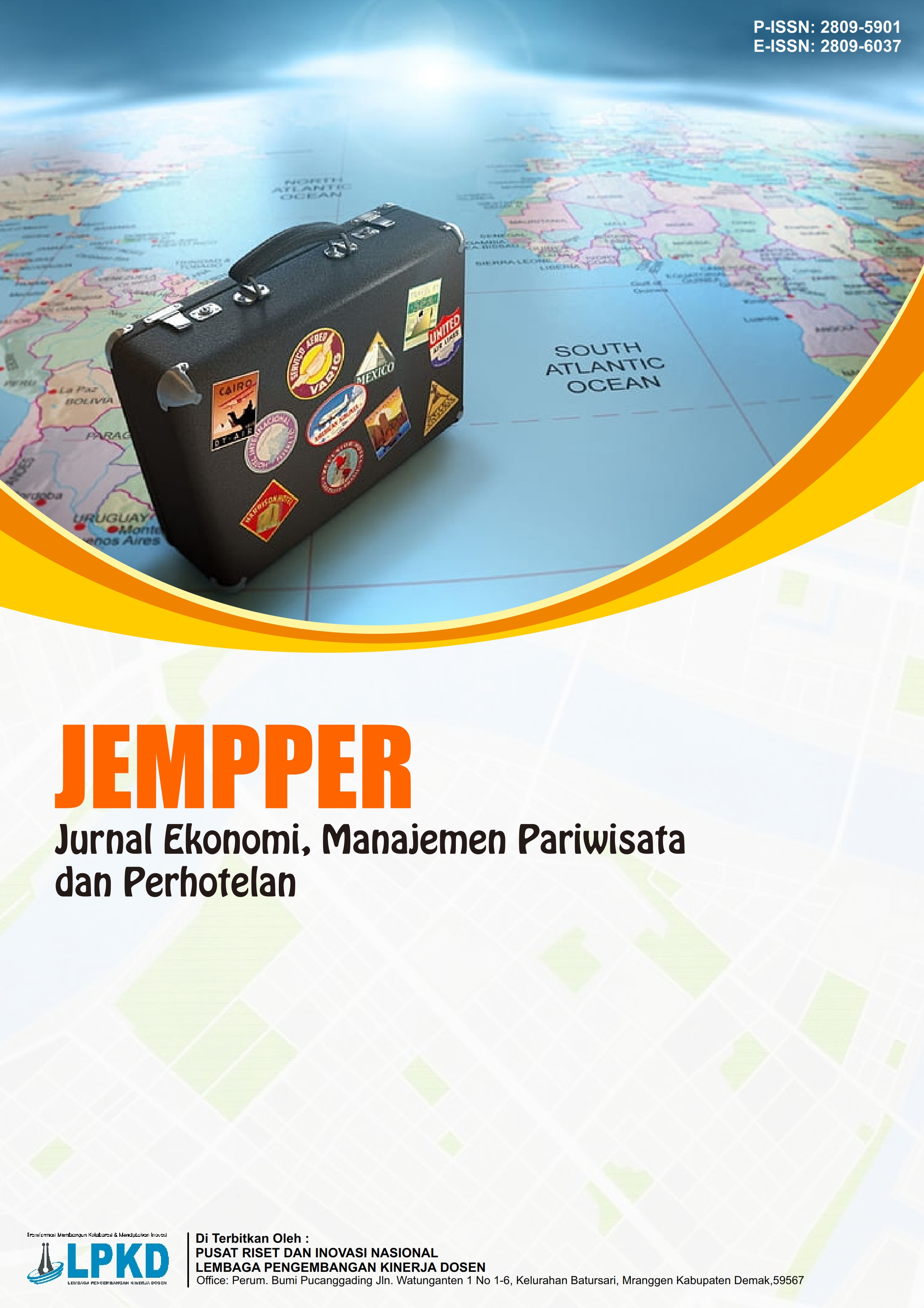Model Destination Branding Berbasis Preferensi Generasi Z terhadap Daya Tarik Wisata Museum di Bali
DOI:
https://doi.org/10.55606/jempper.v4i2.3913Keywords:
Destination Branding, Generation Z, Preference, Tourist Museums in BaliAbstract
Based on the analysis of tourist visits to several museums in Bali, it is evident that the visitation numbers are still low. This study aims to develop a destination branding model based on the preferences of Generation Z tourists to increase visits to museums in Bali. This is a qualitative study, employing data collection techniques such as questionnaires, interviews, and literature reviews. Theories such as tourist gaze, storynomic tourism, and event tourism are applied to enrich understanding and develop the destination branding model. The research findings suggest the importance of integrating components such as attractions, accessibility, amenities, and ancillary to enhance tourist interest in museums in Bali. Additionally, interactive activities, event organization, informative narratives, and tourist reviews can strengthen the appeal of museums in Bali for Generation Z. The proposed destination branding model prioritizes segmentation, targeting, and positioning according to the preferences of Generation Z, with the hope of increasing museum visits and enriching visitor experiences. Although limited to domestic Generation Z tourists and museums in Bali, this study provides a significant contribution to the development of destination branding strategies relevant to the characteristics of Generation Z and can be applied in the cultural tourism context of Bali.
References
Ardika, I. W. (2015). Warisan budaya perspektif masa kini. Universitas Udayana.
Astina, I. W. A. A. B., Mekarini, N. W., & Jokosaharjo, S. (2021). Strategi pengembangan Museum Subak Tabanan sebagai daya tarik wisata budaya. Journal of Tourism and Interdiciplinary Studies, 1(1), 45–53. https://doi.org/10.51713/jotis.v1i1.51
Cooper, C., Fletcher, J., Gilbert, D., & Wanhill, S. (1993). Tourism: Principles & practice. Longman Group.
Getz, D. (2008). Event studies: Theory, research and policy for planned events. Tourism Management, 29(3), 403–428. https://doi.org/10.4324/9781315708027
Hartini, K. S. (2023). Strategi pemasaran Museum Buleleng dalam wisatawan pasca pemberlakuan pembatasan kegiatan masyarakat (PPKM). Jurnal Akademisi dan Praktisi Pariwisata, 3(1), 48–57.
Inskeep, E. (1991). Tourism planning: An integrated and sustainable development approach. John Wiley & Sons, Inc.
Kartika, T., Fajri, K., & Kharimah, R. (2017). Pengembangan wisata heritage sebagai daya tarik Kota Cimahi. Jurnal Manajemen Resort dan Leisure, 14(2). https://ejournal.upi.edu/index.php/jurel/article/view/9102
Kertajaya, H., & Yuswohady. (2005). Positioning diferensiasi brand: Memenangkan persaingan dengan segitiga. PT Gramedia Pustaka Utama. http://www.bukabuku.com/browses/product/9789792208351/positioning-diferensiasi-brand-memenangkan-persaingan-dengan-segitiga.html#
McKee, R., & Gerace, T. (2018). Storynomics: Story-driven marketing in the post-advertising world. Twelve.
Nash, D. (1991). The tourist gaze. Tourism Management, 12(3), [halaman tidak dicantumkan]. https://doi.org/10.1016/0261-5177(91)90017-n
Nisa, R. U. K., & Wiradharma, G. (2019). Kontruksi branding destinasi pariwisata Daerah Istimewa Yogyakarta. Ikraith-Humaniora, 3(1), 53–60. https://journals.upi-yai.ac.id/index.php/ikraith-humaniora/article/download/375/255/
Ohorella, N. R., & Prihantoro, E. (2021). Pengembangan branding pariwisata Maluku berbasis kearifan lokal. Jurnal Komunikasi, 16(1), 89–99. https://doi.org/10.20885/komunikasi.vol16.iss1.art7
Pramesti, D. S., Pitana, I. G., Paturusi, S. A., & Adikampana, I. M. (2023). Tourists’ preferences for the architectural attractions in Bali. Environment-Behaviour Proceedings Journal, 8(26), 419–426. https://doi.org/10.21834/e-bpj.v8i26.5143
Purike, E., Azizah, N., Ajibroto, K., Kesumah, P., & Sujana, N. (2023). Wisata heritage dan kalangan milenial muda di Kota Bandung. Sosial dan Humaniora, 1(1), 1–13. https://e-journal.nalanda.ac.id/index.php/TUTURAN/article/view/109/113
Saeni, A. A., Rahmat, M. F., & Rizaldi, A. R. (2023). Model destination branding Pulau Karampuang. Journal of Economic, Public, and Accounting (JEPA), 5(2), 131–143.
Simanungkalit, R. E. (2022). Peran Gen Z dalam pengembangan wisata berbasis sejarah. Seminar Nasional 2022-NBM Arts, 1–7.
Subhiksu, I. B. K., Ardika, I. W., Darma Putra, N., & Madiun, I. N. (2014). Museums as cultural tourism attractions in Ubud. E-Journal of Tourism, 1(2), 114–127. https://doi.org/10.24922/eot.v1i2.19421
Sugiyono. (2015). Metode penelitian dan pengembangan: Pendekatan kualitatif, kuantitatif, dan R&D. [Penerbit tidak dicantumkan].
Sulistiyawati, S. (2017). Persepsi wisatawan terhadap museum budaya di Ubud. Universitas Udayana.
Sunjayadi, A. (2019). Pariwisata sejarah untuk generasi milenial dan generasi Z. Abad: Jurnal Sejarah, 3(2), 28–41.
Urry, J. (2002). The tourist gaze (2nd ed.). Sage.
Wirayanthi, N. L. Y., & Suryasih, I. A. (2018). Persepsi wisatawan terhadap Museum Bali sebagai daya tarik wisata budaya. Jurnal Destinasi Pariwisata, 5(1), 114. https://doi.org/10.24843/jdepar.2017.v05.i01.p21







